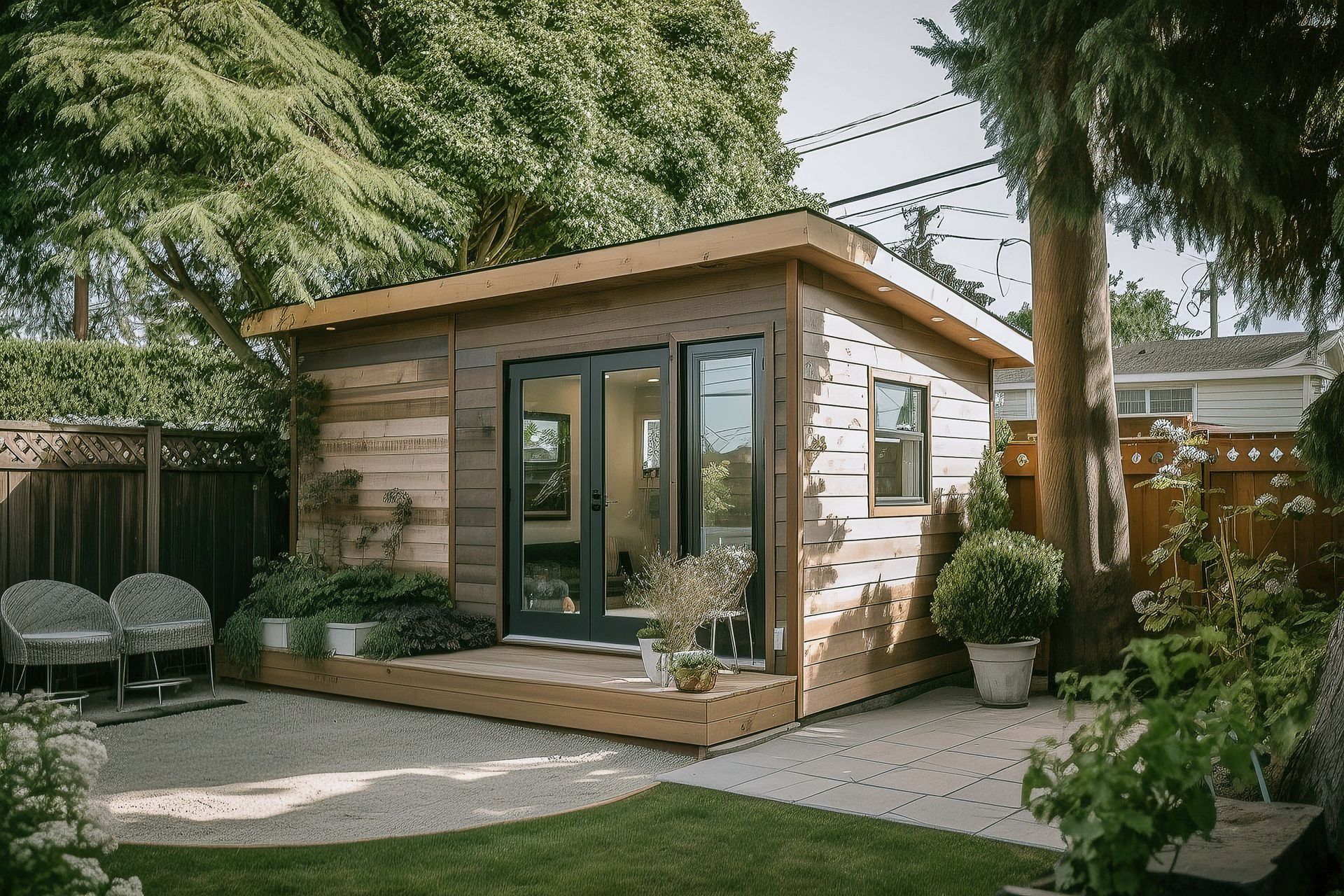Maximizing Your Property: A Deep Dive into ADU Construction

Introduction
In the dynamic realm of real estate, homeowners are continually exploring innovative strategies to optimize their property's potential. A rising trend in this pursuit is the integration of Accessory Dwelling Units (ADUs), presenting homeowners with a means to augment property value and generate extra living space. This comprehensive guide navigates the nuances of ADU construction, delving into pivotal facets like construction expenses, financing alternatives, local accessibility, and legal considerations.
ADUs, also known as granny flats or in-law suites, have gained popularity for their versatility in meeting diverse needs, from providing accommodation for extended family members to serving as rental units for additional income. Understanding the construction costs is vital, as it empowers homeowners to make informed decisions. Factors influencing costs include the size, design, materials used, and local labor rates. By comprehending these variables, homeowners can budget effectively and ensure a feasible investment.
Unlocking Property Potential with ADUs
Maximizing Value and Space
As the real estate landscape evolves, homeowners seek innovative ways to unlock their property's full potential. Accessory Dwelling Units (ADUs) have emerged as a favored solution, enabling homeowners to boost property value and create additional living space. In this comprehensive guide, we delve into the intricacies of ADU construction, exploring crucial aspects such as construction costs, financing options, local availability, and legal considerations.
Navigating the ADU Construction Journey
ADUs, also known as granny flats or backyard cottages, offer a flexible approach to property enhancement. Understanding the construction costs involved is essential. Our guide breaks down these expenses, providing insights into budgeting for this transformative project.
Financial Options and Local Considerations
Financing an ADU project requires careful consideration. We examine various financial options available to homeowners, ensuring a well-informed decision-making process. Local regulations play a pivotal role in ADU construction feasibility. Our guide offers insights into navigating these regulations, making the process smoother for homeowners.
Legal Landscape of ADUs
Legal considerations are paramount in the construction of ADUs. This guide provides an overview of the legal aspects associated with ADU construction, ensuring homeowners are well-versed in compliance and permitting requirements.
Understanding ADUs

Accessory Dwelling Units (ADUs), commonly referred to as granny flats, in-law suites, or backyard cottages, are secondary residential structures situated on the same property as the main dwelling. These adaptable units can fulfill a range of functions, from offering independent living spaces for family members to serving as rental units for supplementary income. Successfully capitalizing on your property's potential hinges on skillfully managing the intricacies of ADU construction, a process that necessitates meticulous planning, adherence to local regulations, and astute financial decision-making.
ADUs have gained popularity as a solution to housing challenges, providing homeowners with the flexibility to accommodate changing family needs or generate additional revenue. Whether you seek to create a private space for aging parents, establish a home office, or pursue rental opportunities, the versatility of ADUs makes them a valuable addition to residential properties.
However, embarking on an ADU construction project requires a comprehensive understanding of local zoning laws and building codes. Municipal regulations can vary, influencing factors such as ADU size, design, and placement on the property. Navigating these intricacies demands a strategic approach, including consultation with local authorities and hiring professionals well-versed in ADU construction.
In conclusion, unlocking the full potential of your property through ADU construction requires a holistic approach. By carefully planning, adhering to local regulations, and making informed financial decisions, homeowners can create functional and valuable living spaces that cater to their specific needs and contribute to the overall livability and value of their property.
ADU Construction Cost: A Crucial Consideration
For homeowners contemplating the construction of an Accessory Dwelling Unit (ADU), a primary concern revolves around the associated costs. The expense of building an ADU can vary considerably, influenced by factors such as size, design, materials, and location. To gain a realistic estimate aligned with their particular requirements, homeowners are advised to engage in thorough research and seek quotes from reputable contractors.
The construction cost of ADUs typically encompasses various elements, including expenses related to site preparation, foundation, framing, roofing, plumbing, electrical work, insulation, and interior finishes. It is essential for homeowners to formulate a comprehensive budget that accounts for potential additional costs. These may include permit fees, utility connections, and landscaping expenses, which can contribute significantly to the overall financial investment.
By being diligent in obtaining accurate quotes and factoring in all potential expenses, homeowners can make informed decisions about the feasibility of their ADU construction project. This proactive approach ensures a more transparent understanding of the financial implications and allows for better planning to bring the ADU construction to fruition within budget constraints.
ADU Construction Loan: Financing Your Project
Financing the construction of an Additional Dwelling Unit (ADU) can be a challenging endeavor for many homeowners. However, there are various financing options available to transform the dream of adding an extra living space into a reality. Traditional routes such as home equity loans and home equity lines of credit (HELOCs) are viable choices. Additionally, government-backed financing programs can offer assistance in funding ADU projects.
For homeowners seeking specialized solutions, financial institutions and lenders provide ADU construction loans tailored to streamline the building process. These loans often come with favorable terms and can be secured based on the anticipated future value of the property once the ADU is completed. This forward-looking approach allows homeowners to leverage the potential value appreciation of their property, making the financing process more accessible.
ADU construction loans typically consider the future income generated by renting out the additional unit, contributing to the feasibility of the project. Exploring these financial avenues empowers homeowners to embark on ADU construction confidently, knowing that there are financing options suited to their needs.
In navigating the financing landscape, homeowners should assess their specific requirements and explore a combination of these financing tools to find the most suitable and cost-effective solution for their ADU project. By understanding the various options available, homeowners can make informed decisions that align with their financial goals and turn their vision of an additional dwelling into a tangible reality.
ADU Construction Near Me: Local Availability and Regulations

The viability of constructing an Additional Dwelling Unit (ADU) is contingent upon adhering to local regulations and zoning laws, which vary across different regions. Homeowners are urged to conduct thorough research to comprehend the regulations governing ADU construction in their specific location. Online resources or consultations with local planning departments can offer valuable insights into zoning requirements, building codes, and permit processes.
In the quest for "ADU construction near me," homeowners should consider enlisting the services of local contractors well-versed in the specific regulations applicable to their area. Leveraging local expertise ensures compliance with building codes and expedites the permitting process, thereby minimizing potential delays and complications. By partnering with professionals familiar with the intricacies of local regulations, homeowners can navigate the ADU construction process smoothly and ensure that their project aligns seamlessly with the governing laws of their specific locality.
ADU Construction Cost Bay Area: Navigating High-Cost Regions
In regions with high living costs, such as the Bay Area, homeowners must be particularly mindful of ADU construction costs. The high demand for housing and skilled labor can significantly impact construction expenses. To navigate the challenges of ADU construction cost in the Bay Area, homeowners should explore cost-saving measures without compromising quality.
Opting for energy-efficient materials, utilizing innovative construction techniques, and obtaining multiple quotes from contractors can help homeowners find cost-effective solutions. Additionally, researching available financing options and taking advantage of government incentives or grants can further offset the expenses associated with ADU construction in high-cost regions.
What States Allow ADUs: Legal Considerations
As the popularity of Additional Dwelling Units (ADUs) continues to grow, it's crucial for homeowners to recognize that the acceptance and regulation of ADUs vary among states. To embark on an ADU construction project successfully, homeowners need to be well-informed about the legal landscape governing ADUs in their particular state.
The regulatory environment for ADUs differs significantly from state to state. Some states have more lenient regulations, facilitating smoother construction processes and permitting, while others may present challenges through restrictions or zoning requirements. It is imperative for homeowners to understand the specific laws and regulations pertaining to secondary dwelling units in their state.
Researching state-specific guidelines is a key step in navigating the legal aspects of ADU construction. Additionally, homeowners should consult with local municipalities to uncover any additional restrictions or specific requirements that may apply to their project. Seeking information from local community organizations and advocacy groups can also offer valuable insights into the current status of ADU regulations and potential changes on the horizon.
By being well-versed in the legal intricacies surrounding ADUs in their state, homeowners can proactively address any challenges, ensuring a smoother and more successful ADU construction
ADU Plans: Tailoring Design to Your Needs

The effectiveness of an Additional Dwelling Unit (ADU) construction project hinges on meticulous planning and thoughtful design. Homeowners must carefully evaluate their needs and objectives for the extra living space, whether it's intended for rental purposes, as a home office, or to accommodate family members. Customizing the design to align with these specific requirements is paramount.
Engaging professional architects or designers to craft personalized ADU plans ensures that the space is not only functional but also aesthetically pleasing and compliant with local building codes. This professional input helps homeowners create a space that meets their unique needs while adhering to regulatory standards. It is crucial to prioritize features that not only enhance the overall value of the property but also maintain practicality and efficiency in the utilization of the ADU.
By investing in thoughtful design and planning, homeowners can optimize the functionality and appeal of the ADU. This strategic approach not only contributes to the immediate satisfaction of their needs but also adds long-term value to the property. Ultimately, a well-designed ADU enhances the overall livability and marketability of the property, making it a worthwhile investment for homeowners.
ADU Requirements: Navigating Regulatory Compliance
To avoid setbacks during the construction process, homeowners must be well-versed in ADU requirements set forth by local municipalities. These requirements typically encompass aspects such as maximum size limits, setback regulations, parking provisions, and landscaping guidelines.
Compliance with ADU requirements is essential to secure the necessary permits and approvals. Homeowners should work closely with their chosen contractor and engage with local planning departments to ensure that the proposed ADU meets all regulatory standards. Failure to comply with requirements may result in delays, fines, or even the inability to complete the construction project.
ADU Cost: Balancing Investment and Return
Although constructing an Additional Dwelling Unit (ADU) comes with initial expenses, homeowners should perceive it as a lasting investment with the prospect of substantial returns. The extra living space holds the potential to enhance overall property value, generate rental income, or adapt to evolving family needs.
To strike a balance between the costs associated with ADU construction and the potential return on investment, homeowners need to engage in meticulous financial planning. This entails a thorough assessment of budget constraints, exploration of available financing options, and a consideration of how the ADU may impact the property's overall value. It's crucial for homeowners to approach the feasibility of ADU construction with a comprehensive understanding of both the short-term costs and the long-term benefits.
Collaborating with financial advisors and real estate professionals can prove invaluable in gaining insights into the financial implications of this strategic property enhancement. Their expertise can assist homeowners in making informed decisions about the investment, ensuring that the ADU not only meets their immediate needs but also contributes positively to the property's value over time. By adopting a forward-looking perspective and seeking professional guidance, homeowners can navigate the financial aspects of ADU construction effectively and maximize the potential returns on their investment.
Conclusion

Maximizing your property through ADU construction is a multifaceted endeavor that involves careful consideration of construction costs, financing options, local regulations, and design requirements. By conducting thorough research, collaborating with local experts, and navigating the legal landscape, homeowners can unlock the full potential of their properties.
Whether you're exploring ADU construction for additional income, housing family members, or enhancing property value, the key is to approach the process with a well-informed and strategic mindset. As the demand for housing alternatives continues to grow, ADUs stand as a versatile and valuable solution for homeowners looking to make the most of their real estate investments.
By staying abreast of the latest trends, leveraging available resources, and understanding the specific dynamics of your location, you can embark on a successful ADU construction journey that transforms your property into a dynamic and lucrative asset.
Frequently Asked Questions - ADU Construction Guide










